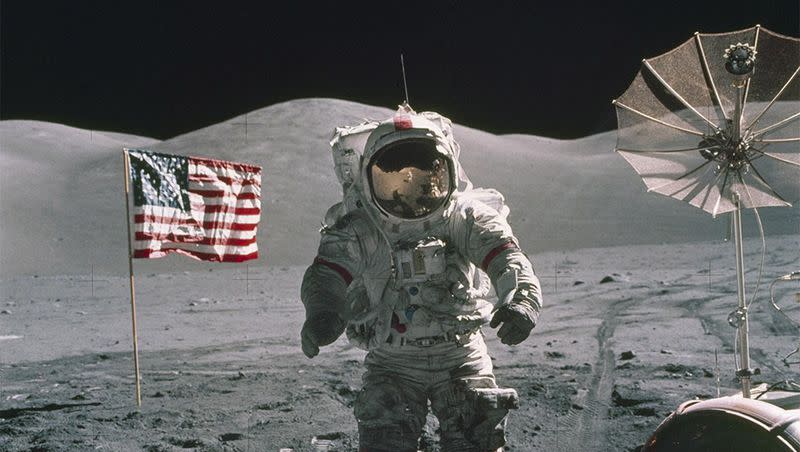Apollo 17 lander left behind on moon is causing moonquakes, study finds

It’s been more than 50 years since the United States landed on the moon for its seventh lunar mission.
This week, a new study published in the journal of Advancing Earth and Space Sciences used eight months of seismologial data collected between 1976 to 1977 from equipment left during the Apollo 17 mission, to find unnatural moonquakes. Researchers believe the lunar lander left by the mission is causing the moon to quake.
“We found the impulsive moonquakes are not due to natural processes,” the authors wrote in the study, “but are vibrations generated form the lunar module descent vehicle left by the astronauts in 1972.”
Because the lunar lander heats and cools with the extreme temperatures, ranging form -208 degrees Fahrenheit to 250 degrees Fahrenheit, the crust rumbles as it adjusts to a new temperature. Researchers found that the lunar lander adjusting to the extreme temperatures would shake the ground.
“Every lunar morning when the sun hits the lander, it starts popping off,” said study coauthor Allen Husker, a research professor of geophysics at Caltech, per CNN. “Every five to six minutes (there was) another one, over a period of five to seven Earth hours. They were incredibly regular and repeating.”
What are moonquakes?
Moonquakes are similar to earthquakes because both are characterized by seismological vibrations. There are four types of moonquakes, three of which are relatively harmless, Clive R. Neal, an associate professor at Notre Dame, and a group of scientists found in 2006, per NASA.
What are moonquakes caused by?
Neal’s work found that deep, vibrational and thermal quakes are all fairly harmless, but shallow quakes are the most destructive as they are the closest to the surface.
Types of moonquakes:
Deep: About 700 kilometers below the surface.
Shallow: Occurs at only 20 or 30 kilometers below the surface, and last up to 10 minutes.
Vibrational: Usually resulting from impacting meteorites.
Thermal quakes: Caused by expansion of the crust when the sun warms the surface following subzero temps during the night.
Are moonquakes stronger than earthquakes?
Per a paper published by World Scientific News, earthquakes are larger in magnitude than earthquakes, although moonquakes are known to last a lot longer. Shallow moonquakes have registered up to a 5.5 magnitude by Apollo astronauts.
How often do moonquakes occur?
Moonquakes happen as often as every 27 days, and as temperatures change from night to day and day to night, which amounts to 7,000 in a decade, reported the Atlantic.
How many times have humans landed on the moon?
What countries have been to the moon?
India was the most recent country to travel to the moon in 2023, following the United States, Russia and China.
Angela Marusiak, who is an assistant research professor at the University of Arizona’s Lunar and Planetary Laboratory, told CNN that India’s lunar lander mission, Chandrayaan-3, that recently got to the moon included a seismometer which could be useful for future data.
The Indian Space Research Organization has already confirmed that the instrument was able to detect a moonquake, although more extensive data hasn’t been released, per the Department of Space Idian Space Research Organization.
Related
“I’m hoping that with the Artemis program, seismometers will continue to be included because they are really vital for understanding what goes on, not just at the very surface, but even deeper down into the regolith (soil),” Marusiak told CNN.
How monitoring moonquakes can help with future lunar trips
Understanding more about moonquakes could be helpful in future missions to the moon, experts say per CNN, including if NASA builds a permanent outpost there.
“It’s important to know as much as we can from the existing data so we can design experiments and missions to answer the right questions,” Husker told CNN. “The moon is the only planetary body other than the Earth to have had more than one seismometer on it at a time. It gives us the only opportunity to thoroughly study another body.”
Related

